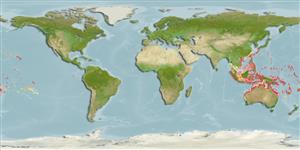Common names from other countries
>
Eupercaria/misc (Various families in series Eupercaria) >
Lethrinidae (Emperors or scavengers) > Lethrininae
Etymology: Lethrinus: Greek, lethrinia, a fish pertaining to genus Pagellus.
More on author: Seale.
Environment: milieu / climate zone / depth range / distribution range
экология
морской ассоциированный с рифами; немигрирующий; пределы глубины 2 - 30 m (Ref. 2295), usually 2 - 18 m (Ref. 37816). Tropical; 31°N - 32°S, 96°E - 134°W
Pacific Ocean: Indonesia and Philippines, north to southern Japan, south to Australia, east to the Tuamoto Islands. Has most frequently been named Lethrinus mahsena.
Length at first maturity / Size / Вес / Возраст
Maturity: Lm ?, range 28 - ? cm
Max length : 50.0 cm TL самец/пол неопределен; (Ref. 48635); common length : 32.5 cm TL самец/пол неопределен; (Ref. 2295); наибольший возраст (опубликованны данные): 24 годы (Ref. 2290)
колючие лучи спинного плавника (общее число) : 10; членистые (мягкие) лучи спинного плавника (общее число) : 9; колючие лучи анального плавника: 3; членистые (мягкие) лучи анального плавника: 8.
Inhabits seagrass beds and sandy areas of lagoons and outer reef slopes. Found singly or in schools. Feeds mainly on crustaceans, mollusks, and fish. Marketed fresh (Ref. 9775).
Life cycle and mating behavior
Maturities | размножение | Spawnings | Egg(s) | Fecundities | личинки
Gonochorism is inferred for this species as sizes of males and females overlapped and male gonad morphology is typical of secondarily derived testes (Ref. 103751). Juvenile hermaphroditism is exhibited by this species (Ref. 35994).
Carpenter, K.E. and G.R. Allen, 1989. FAO Species Catalogue. Vol. 9. Emperor fishes and large-eye breams of the world (family Lethrinidae). An annotated and illustrated catalogue of lethrinid species known to date. FAO Fish. Synop. 125(9):118 p. Rome: FAO. (Ref. 2295)
Статус Красного Списка МСОП (Ref. 130435)
CITES (Ref. 128078)
Not Evaluated
Угроза для людей
Harmless
Использование человеком
рыболовство: не имеет хозяйственного значения; объект спортивного рыболовства: да
дополнительная информация
инструменты
Специальные отчеты
Скачать в формате XML
ресурсы в Интернет
Estimates based on models
Preferred temperature (Ref.
115969): 25.1 - 29.3, mean 28.6 (based on 2744 cells).
Phylogenetic diversity index (Ref.
82804): PD
50 = 0.5000 [Uniqueness, from 0.5 = low to 2.0 = high].
Bayesian length-weight: a=0.01585 (0.01028 - 0.02443), b=3.00 (2.88 - 3.12), in cm Total Length, based on LWR estimates for this species & Genus-body shape (Ref.
93245).
Trophic level (Ref.
69278): 3.8 ±0.0 se; based on diet studies.
устойчивость к внешним воздействиям (Ref.
120179): средний (среднего размера), минимальное время удвоения популяции 1.4-4.4 года (K=0.29-0.31; tm=3.7-5; tmax=24).
Prior r = 0.49, 95% CL = 0.33 - 0.74, Based on 1 data-limited stock assessment.
Fishing Vulnerability (Ref.
59153): Moderate vulnerability (35 of 100).
